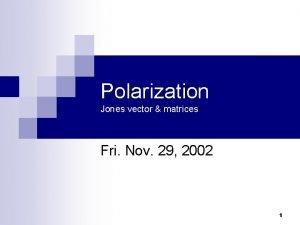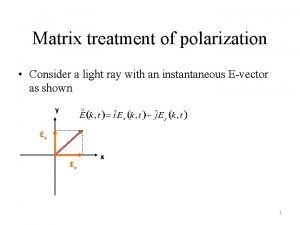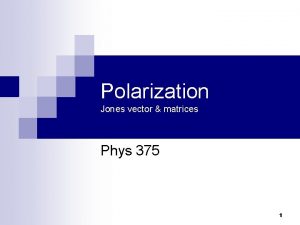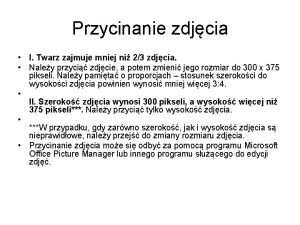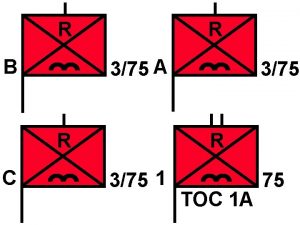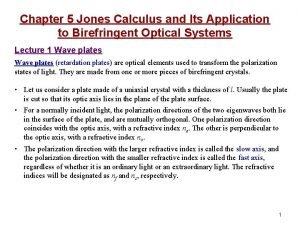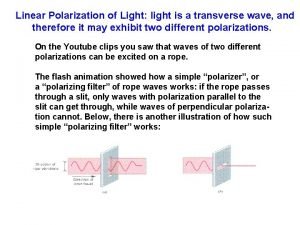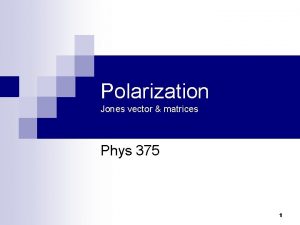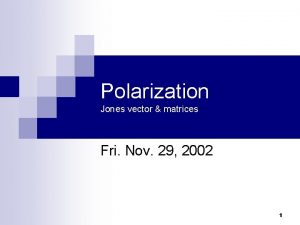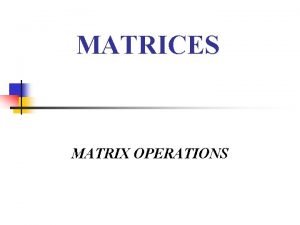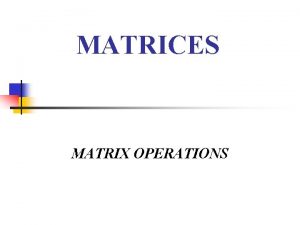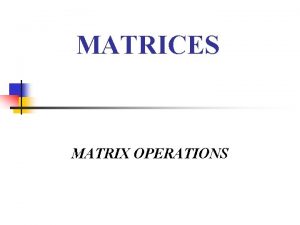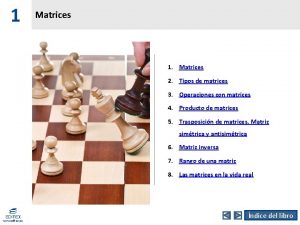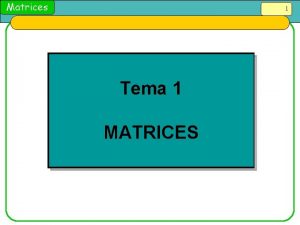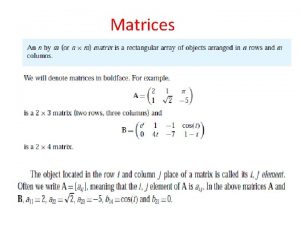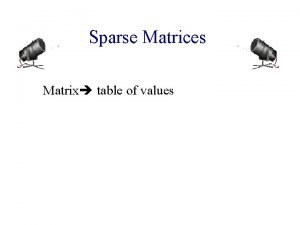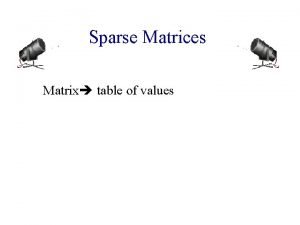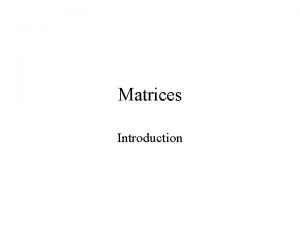Polarization Jones vector matrices Phys 375 1 Matrix





















- Slides: 21

Polarization Jones vector & matrices Phys 375 1

Matrix treatment of polarization n Consider a light ray with an instantaneous Evector as shown y Ey Ex x 2

Matrix treatment of polarization n Combining the components n The terms in brackets represents the complex amplitude of the plane wave 3

Jones Vectors n The state of polarization of light is determined by the relative amplitudes (Eox, Eoy) and, ¨ the relative phases ( = y - x ) of these components ¨ n The complex amplitude is written as a twoelement matrix, the Jones vector 4

Jones vector: Horizontally polarized light n n The electric field oscillations are only along the x-axis The Jones vector is then written, The arrows indicate the sense of movement as the beam approaches you y x where we have set the phase x = 0, for convenience The normalized form is 5

Jones vector: Vertically polarized light n n n The electric field oscillations are only along the y-axis The Jones vector is then written, Where we have set the phase y = 0, for convenience y x The normalized form is 6

Jones vector: Linearly polarized light at an arbitrary angle n n If the phases are such that = m for m = 0, 1, 2, 3, … Then we must have, y x and the Jones vector is simply a line inclined at an angle = tan-1(Eoy/Eox) since we can write 7

Circular polarization y n n n Suppose Eox = Eoy = A and Ex leads Ey by 90 o= /2 At the instant Ex reaches its maximum displacement (+A), Ey is zero A fourth of a period later, Ex is zero and Ey=+A x t=0, Ey = 0, Ex = +A t=T/8, Ey = +Asin 45 o, Ex = Acos 45 o t=T/4, Ey = +A, Ex = 0 8

Circular polarization n The Jones vector for this case – where Ex leads Ey is n The normalized form is, n This vector represents circularly polarized light, where E rotates counterclockwise, viewed head-on This mode is called left-circularly polarized light What is the corresponding vector for right-circularly polarized light? n n Replace /2 with - /2 to get 9

Elliptically polarized light n n If Eox Eoy , e. g. if Eox=A and Eoy = B The Jones vector can be written counterclockwise Here A>B 10

Jones vector and polarization n In general, the Jones vector for the arbitrary case is an ellipse ( m ; (m+1/2) ) y Eoy b a x Eox 11

Optical elements: Linear polarizer n Selectively removes all or most of the Evibrations except in a given direction TA y x Linear polarizer 12

Jones matrix for a linear polarizer Consider a linear polarizer with transmission axis along the vertical (y). Let a 2 X 2 matrix represent the polarizer operating on vertically polarized light. The transmitted light must also be vertically polarized. Thus, Operating on horizontally polarized light, Thus, Linear polarizer with TA vertical. 13

Jones matrix for a linear polarizer n For a linear polarizer with a transmission axis at 14

Optical elements: Phase retarder n n Introduces a phase difference (Δ ) between orthogonal components The fast axis(FA) and slow axis (SA) are shown FA y x SA Retardation plate 15

Jones matrix of a phase retarder n We wish to find a matrix which will transform the elements as follows: n It is easy to show by inspection that, n Here x and y represent the advance in phase of the components 16

Jones matrix of a Quarter Wave Plate n n Consider a quarter wave plate for which |Δ | = /2 For y - x = /2 (Slow axis vertical) Let x = - /4 and y = /4 The matrix representing a Quarter wave plate, with its slow axis vertical is, 17

Jones matrices: Half-wave Plate n For |Δ | = HWP, SA vertical HWP, SA horizontal 18

Optical elements: Quarter/Half wave plate n When the net phase difference Δ = /2 : Quarter-wave plate Δ = : Half-wave plate /2 19

Optical elements: Rotator n Rotates the direction of linearly polarized light by a particular angle y x SA Rotator 20

Jones matrix for a rotator n n n An E-vector oscillating linearly at is rotated by an angle Thus, the light must be converted to one that oscillates linearly at ( + ) One then finds 21
 Jones vector elliptical polarization
Jones vector elliptical polarization Jones vector elliptical polarization
Jones vector elliptical polarization Quarter wave plate jones matrix
Quarter wave plate jones matrix General vector
General vector Ludlum 375
Ludlum 375 300 x 375 pikseli
300 x 375 pikseli Csc 375
Csc 375 75 entre 3
75 entre 3 Com(2018) 375 final
Com(2018) 375 final Umdearborn vpn
Umdearborn vpn Rm 375-tr-2008 iluminacion
Rm 375-tr-2008 iluminacion 1400/375
1400/375 Deret geometri formula
Deret geometri formula Zavet 375
Zavet 375 Jones calculus
Jones calculus Resolution of vectors
Resolution of vectors Define position vector with example
Define position vector with example Unit vector example
Unit vector example Vector
Vector Rainbow total internal reflection
Rainbow total internal reflection Concentration polarization
Concentration polarization Linear polarization
Linear polarization
